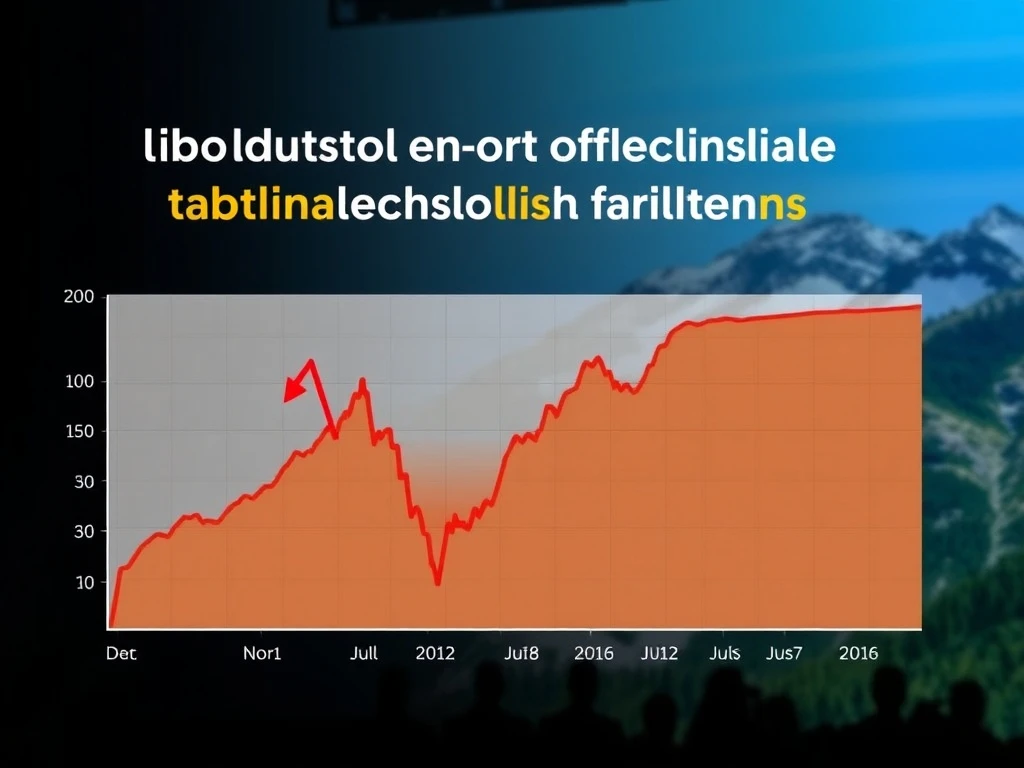Investors and market watchers are on high alert. A prominent strategist recently issued a stark warning: without a specific Jackson Hole Signal, stocks could face a significant 15% decline this autumn. This forecast highlights the immense influence of central bank communications on market stability. Understanding this potential trigger is crucial for anyone involved in business and entrepreneurship. Therefore, market participants are keenly awaiting clarity from the upcoming economic symposium.
The Critical Jackson Hole Signal for Global Markets
The annual Jackson Hole Economic Symposium is a highly anticipated event. Hosted by the Federal Reserve Bank of Kansas City, it gathers central bankers, finance ministers, academics, and financial market participants from around the world. This meeting often provides critical insights into future monetary policy. Historically, Federal Reserve chairs have used this platform to announce significant policy shifts. For instance, former Fed Chair Ben Bernanke hinted at quantitative easing here. Therefore, the market carefully scrutinizes every statement. This year, the focus intensifies on identifying a clear Jackson Hole Signal regarding the Fed’s stance on interest rates and inflation.
The symposium’s agenda typically centers on a pressing economic theme. Discussions often shape global financial strategies. Central bankers exchange views on current economic challenges. Consequently, their collective insights can guide market expectations. Investors understand that any strong indication of the Fed’s future path serves as a vital Jackson Hole Signal. This signal can either reassure markets or trigger widespread re-evaluations of asset prices. Ultimately, its absence could leave investors uncertain, contributing to potential instability.
Unpacking the 15% Stock Slide Forecast
One strategist’s recent warning resonates deeply within financial circles. This analyst suggests that without a clear, growth-supportive Jackson Hole Signal, the stock market could slide by 15% in the fall. This prediction is not arbitrary. It stems from concerns about lingering inflation, rising interest rates, and a potential economic slowdown. Moreover, a lack of forward guidance from the Federal Reserve could exacerbate market jitters. Investors thrive on certainty, and policy ambiguity often leads to risk aversion.
The strategist’s rationale focuses on the market’s current valuations. Many believe current stock prices already factor in an optimistic economic outlook. However, if the Fed signals a more hawkish stance, or fails to provide a clear path to economic stability, these valuations could quickly adjust downwards. Such an adjustment could easily lead to a significant market correction. Consequently, a 15% slide becomes a plausible scenario. The absence of a reassuring Jackson Hole Signal, therefore, acts as a primary catalyst for this projected downturn. It implies that the Fed might not be ready to ease its restrictive policies, potentially dampening economic growth.
Decoding the Crucial Jackson Hole Signal
What specific Jackson Hole Signal are strategists looking for? Analysts are primarily seeking clarity on three key areas of monetary policy. First, they want to understand the Fed’s updated outlook on inflation. Is it truly transitory, or more persistent? Second, investors are keen for signals regarding future interest rate hikes. Will the Fed pause, or continue its aggressive tightening? Finally, the market seeks guidance on quantitative tightening (QT). How long will the Fed continue to shrink its balance sheet?
A ‘good’ Jackson Hole Signal would involve the Fed communicating a clear, consistent, and growth-supportive policy path. This might include:
- **Clear Inflation Outlook:** A confident assessment that inflation is receding.
- **Rate Hike Pause:** Hints at a potential pause in rate increases.
- **QT Adjustments:** Discussions about slowing or ending quantitative tightening.
Conversely, a ‘bad’ signal would imply continued aggressive tightening. This could include a hawkish surprise or a lack of forward guidance. The market needs to feel confident that the Fed understands the economic landscape. It also needs to believe the Fed is prepared to act decisively. Without this reassurance, volatility could surge. Therefore, the tone and specific language used by policymakers will be meticulously analyzed.
Broader Economic Landscape Influencing the Outlook
While the Jackson Hole Signal is paramount, other economic factors also influence the stock market’s trajectory. Global economic growth remains a concern. Geopolitical tensions, particularly in Eastern Europe, continue to create uncertainty. Furthermore, supply chain disruptions, although easing, still pose risks. Energy prices, consumer spending patterns, and the strength of the labor market are also critical indicators. These factors collectively paint a broader economic picture. They can either reinforce or counteract the impact of any message from Jackson Hole.
For example, robust consumer spending could offset some negative sentiment. However, persistently high inflation could force the Fed to maintain its hawkish stance, regardless of other factors. Similarly, strong corporate earnings could provide a buffer against market downturns. Yet, a weakening jobs market might signal an impending recession. Ultimately, the market will weigh the Jackson Hole Signal against these prevailing economic conditions. This comprehensive assessment will determine the true direction of stocks in the coming months. Therefore, investors must monitor a wide array of economic data points, not just central bank pronouncements.
Investor Strategies Amidst Uncertainty
Given the potential for a 15% stock slide, investors should consider reviewing their portfolios. Prudent strategies can help mitigate risks. Diversification across different asset classes remains a cornerstone of sound investing. This includes bonds, real estate, and commodities, not just stocks. Rebalancing portfolios periodically can also help manage risk exposure. For instance, reducing exposure to highly volatile growth stocks might be wise. Conversely, increasing positions in stable, dividend-paying companies could offer some protection. A clear Jackson Hole Signal, or lack thereof, should inform these adjustments.
Furthermore, maintaining a healthy cash position provides flexibility. It allows investors to capitalize on potential market dips. Cost averaging, or investing a fixed amount regularly, can also smooth out returns over time. Finally, staying informed is critical. Regularly monitoring economic news and central bank statements can help investors make timely decisions. While no strategy guarantees protection against market downturns, a proactive approach can certainly reduce potential losses. The Jackson Hole Signal will offer vital clues for these strategic adjustments. Consequently, vigilance is key.
Past Jackson Hole Impacts on Stocks
The Jackson Hole symposium has a history of moving markets. In 2010, then-Fed Chair Ben Bernanke used his speech to hint at a second round of quantitative easing. This unexpected announcement sent stock markets soaring. Investors interpreted it as a strong signal of continued monetary support. Conversely, in 2022, Chair Jerome Powell delivered a decidedly hawkish speech. He emphasized the Fed’s commitment to fighting inflation, even if it meant economic pain. This firm stance immediately triggered a market sell-off. The S&P 500 dropped sharply following his remarks. These examples underscore the symposium’s profound influence.
The market’s reaction to the Jackson Hole Signal is not always straightforward. Sometimes, the market has already priced in expectations. Other times, a surprise announcement can cause significant volatility. Nevertheless, the event consistently captures global attention. It provides a unique opportunity for policymakers to communicate their intentions directly. Therefore, the upcoming symposium carries substantial weight. Investors will analyze every word for indications of future policy. The potential for a 15% slide highlights the high stakes involved. Understanding historical precedents helps contextualize the current concerns.
The strategist’s warning about a 15% stock slide hinges on the outcome of the Jackson Hole symposium. A clear, reassuring Jackson Hole Signal could provide the stability markets desperately need. Conversely, ambiguity or a hawkish surprise could trigger the predicted downturn. Investors must remain vigilant. They should prepare their portfolios for potential volatility. Monitoring central bank communications and broader economic indicators is crucial. Ultimately, the fall market’s direction may well be decided by the messages emanating from Wyoming. The importance of the Jackson Hole Signal cannot be overstated.
Frequently Asked Questions (FAQs)
1. What is the Jackson Hole Symposium?
The Jackson Hole Economic Symposium is an annual conference hosted by the Federal Reserve Bank of Kansas City. It brings together central bankers, finance ministers, academics, and market participants from around the world. They discuss key economic issues and monetary policy.
2. Why is the Jackson Hole Signal so important for stock markets?
The symposium is often used by Federal Reserve chairs to hint at significant shifts in monetary policy. Any clear communication, or lack thereof, regarding interest rates, inflation, or quantitative easing can act as a crucial Jackson Hole Signal. This signal can significantly impact investor sentiment and market direction.
3. What kind of Jackson Hole Signal could lead to a 15% stock slide?
A strategist warns that the absence of a clear, growth-supportive Jackson Hole Signal could cause a 15% stock slide. This might include a surprisingly hawkish stance from the Fed, a lack of clear forward guidance on policy, or an indication that high interest rates will persist longer than expected, dampening economic growth prospects.
4. How can investors prepare for potential market volatility after Jackson Hole?
Investors can prepare by diversifying their portfolios across various asset classes, rebalancing regularly, and maintaining a healthy cash position. Staying informed about central bank communications and broader economic trends is also crucial. These strategies can help mitigate risks associated with an unclear Jackson Hole Signal.
5. Has the Jackson Hole Symposium impacted markets in the past?
Yes, historically, speeches at Jackson Hole have often moved markets. For example, in 2010, hints of quantitative easing boosted stocks. In 2022, a hawkish speech by Chair Powell led to a significant market sell-off. These instances highlight the event’s powerful influence on market sentiment and direction.
















